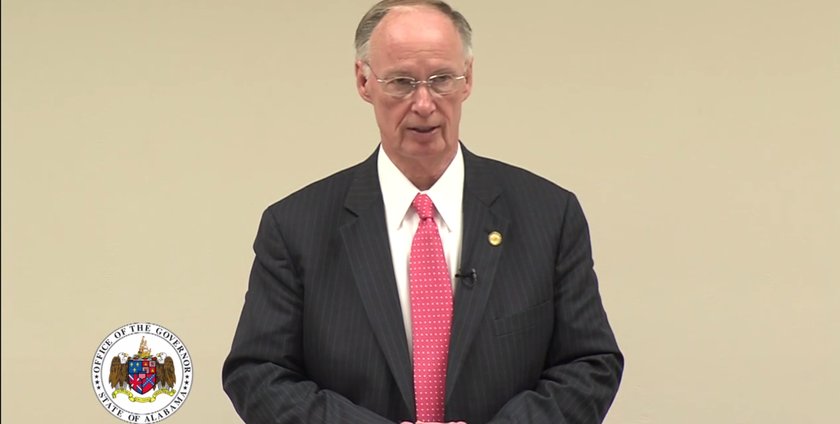
MONTGOMERY, Ala. — The top officials in all three branches of Alabama’s state government came together on Tuesday to announce the launch of the Justice Reinvestment Initiative (JRI), a comprehensive study of the state’s criminal justice system aimed at finding solutions to the serious issues facing Alabama’s underfunded, overcrowded prisons.
“The Justice Reinvestment Initiative is an opportunity for Alabama to examine the criminal justice system in order to reduce prison crowding and increase public safety,” said Gov. Robert Bentley. “The number of inmates incarcerated in Alabama has significantly increased over the last decade. With the Justice Reinvestment Initiative, we have an opportunity to examine areas to maximize efforts in the criminal justice system that will benefit our Department of Corrections. By participating in the study, we will have a detailed understanding of drivers behind Alabama’s prison population growth and identify ways to reduce growth.”
Alabama’s prison system garnered the state some unwanted national media attention earlier this year when news broke that conditions in the Julia Tutwiler Prison for Women were at one time so bad they may have violated the inmates’ constitutional rights.
But while Tutwiler has been the proverbial poster child for Alabama’s prison problems, it’s the larger overcrowding issue that threatens to destabilize the entire system. To put it plainly, Alabama has the most serious prison overcrowding problem in the country. It’s so bad, in fact, that Alabama is running the risk of federal courts stepping in and ordering the haphazard release of thousands of prisoners from the state’s lockups.
RELATED:
1. Legislators must reform Alabama’s prisons or risk a federal judge doing it for us
2. Alabama’s dangerously overcrowded prisons attract national attention
California serves as an example of what can happen when the federal government is forced to intervene.
In the 2011 Supreme Court case Brown v. Plata, the Court required the State of California to remove 46,000 criminals from its prisons by forcing The Golden State to cut its prison population to 137.5 percent of “design capacity.”
The Public Policy Institute of California found that property crime increased by 7.6 percent the year after the mass releases. Car thefts rose almost 15 percent. In short, 24,000 more people had their car stolen in California in 2012 as a result of the state not being able to get its prison overcrowding problem under control.
Alabama’s prisons are at roughly 190 percent capacity, 50 percent higher than the level the Court mandated for California. The Yellowhammer State currently houses over 25,000 inmates in facilities designed to hold approximately 13,000.
The cost of corrections consumes a large share of Alabama’s General Fund Budget, depleting resources for other parts of the criminal justice system, like probation and parole supervision and community-based drug treatment, which can reduce recidivism at a lower cost.
But in spite of the overcrowding, The Alabama Department of Corrections currently spends the lowest amount of any state in the country to house inmates. Corrections Commissioner Kim Thomas said participating in the JRI is a unique opportunity to focus on making Alabama’s criminal justice system more efficient.
“No one strategy or group alone is going to improve Alabama’s criminal justice system,” said Thomas. “In order to make significant and long-lasting improvements, it is going to take a host of stakeholders and partners working together on dynamic, evidence-based solutions. Alabama’s participation in this Justice Reinvestment Initiative represents its willingness to devote the time and energy necessary to make those improvements”

The JRI will be spearheaded by nearly 30 sate leaders, known collectively as the Prison Reform Task Force. The group, which is chaired by State Sen. Cam War (R-Alabaster), held its first meeting Tuesday, with plans to begin examining criminal justice trends, review successful approaches used by other states facing similar challenges and identify key areas to explore during the study.
“This is the biggest challenge our state has ever faced,” Ward said. “Alabama has to start being not only tough on crime but we have to be smart on crime. This effort represents a unified effort by all three branches of government to accomplish this goal”
Chief Justice of the Alabama Supreme Court Roy Moore said the problems in Alabama’s prison system have put an increased strain on the judicial branch.
“It is no secret that Alabama’s prison system is in a crisis,” said Moore. “The struggles our state faces with prison population, sentencing proportionality, and victim restitution strain not only the resources of our corrections system, but also our overworked court system. The judiciary interfaces every day with criminal offenders on either side of the prison bars, so I look forward to working with leaders from all branches of our state government, as well as the U.S. Department of Justice, to improve our prison system.”
The Prison Reform Task Force will meet routinely between June and December, and is expected to have policy options ready for the Legislature to consider in 2015.
Legislative leaders said that Alabama’s approach to addressing the state’s prisons problem shows a stark contrast between the way the state and federal governments operate.
“At a time when the federal government continues to showcase its inability to work together, in Alabama we’re proving that every branch of government can come together to work toward a common goal,” said House Speaker Mike Hubbard.
“This partnership provides a unique opportunity for three branches of government to fully examine the challenges in our criminal justice system and determine the best path forward,” added Senate President Pro Tem Del Marsh said. “I appreciate the leadership of Governor Bentley, my Senate colleague Cam Ward and others involved for their hard work and willingness to address these issues.”
Follow Cliff on Twitter @Cliff_Sims









